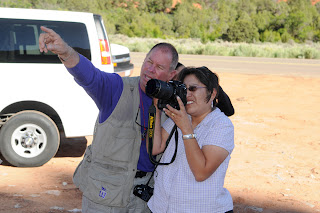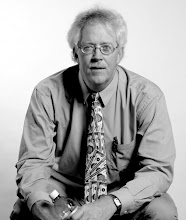


The morning was spent in class, talking about the interviews with the Navajo elders conducted the day before. Students reflected on content they collected and what else they needed to find out about their interview subjects. They talked about sources to verify details, other secondary interviews to bring depth and breadth to the stories of the elders, and photos needed. They began to plan the second and third interviews.
After another great lunch in the Diné College cafeteria, the afternoon was designated free time. Many students further researched their documentary projects. Others got into groups to share expertise with software or camera equipment and practice.
(photo by Matt Wandzel)
Chops Hancock offered to lead a photo workshop in the late afternoon, searching for excellent "magic hour" shots with the beautiful landscape bathed in the warm glow and saturated colors of the late-day sun.
(Photo by Andrew Neumann)
(photo of "Butt Rock" by Brandi Hagen)
(Photo by Andrew Neumann)
(Photo by Danny John)
(Photo by Cindy Killion)
(The previous two images are by Chops Hancock. Earlier in the blog, I stated "unless otherwise noted, all photos by Chops, myself, or Cindy Killion." These two images are so stunning, Chops deserves specific credit.)
This was only our third full day here, but already many of the students from both Diné College and Winona State University feel comfortable in their surroundings and are becoming good friends and journalism partners. It's common to hear students helping each other with interview ideas, constructive criticism on images, tips on camera settings and more.
This is what it is all about: faculty members get students together, give them tools and ideas and a framework in which to operate, and let them put their skills and abilities to good use. Then we stand back and watch them work and offer help when needed.
Some of the work these students are doing is very difficult. The interviews can be challenging, even moreso with a significant cultural or language barrier or both.
I'm proud of these students. They're taking the challenge head-on and finding ways to solve problems and create meaningful documentaries. They have a sense of ownership in their projects. When they're done, they can look back at the process and be confident they found ways to be successful and to make a difference in the lives of their interviewees, in their own lives, and-- perhaps most importantly-- in the world, by virtue of sharing stories that might never have been told otherwise.
Each evening we have a fire in our dorm building's fireplace, which is in the center of our octagon-shaped building. The building shape and central position for the fire replicates a traditional Navajo hogan, where the fire holds a central place in the home, in life and in living healthy and spiritual lives in harmony with nature.
(photo by Matt Wandzel)














No comments:
Post a Comment